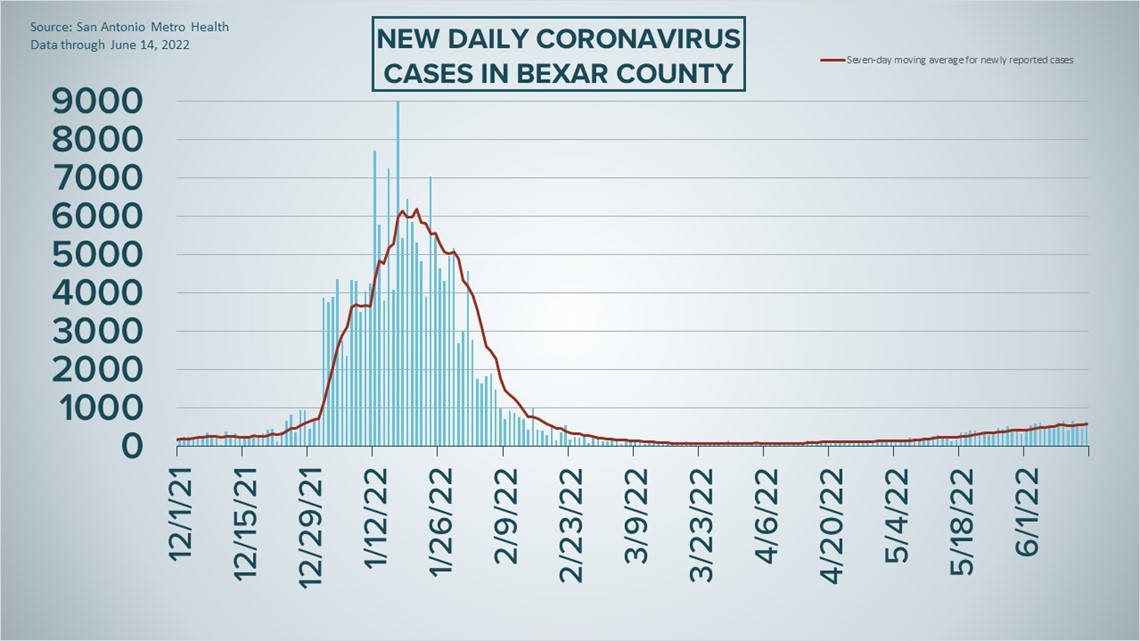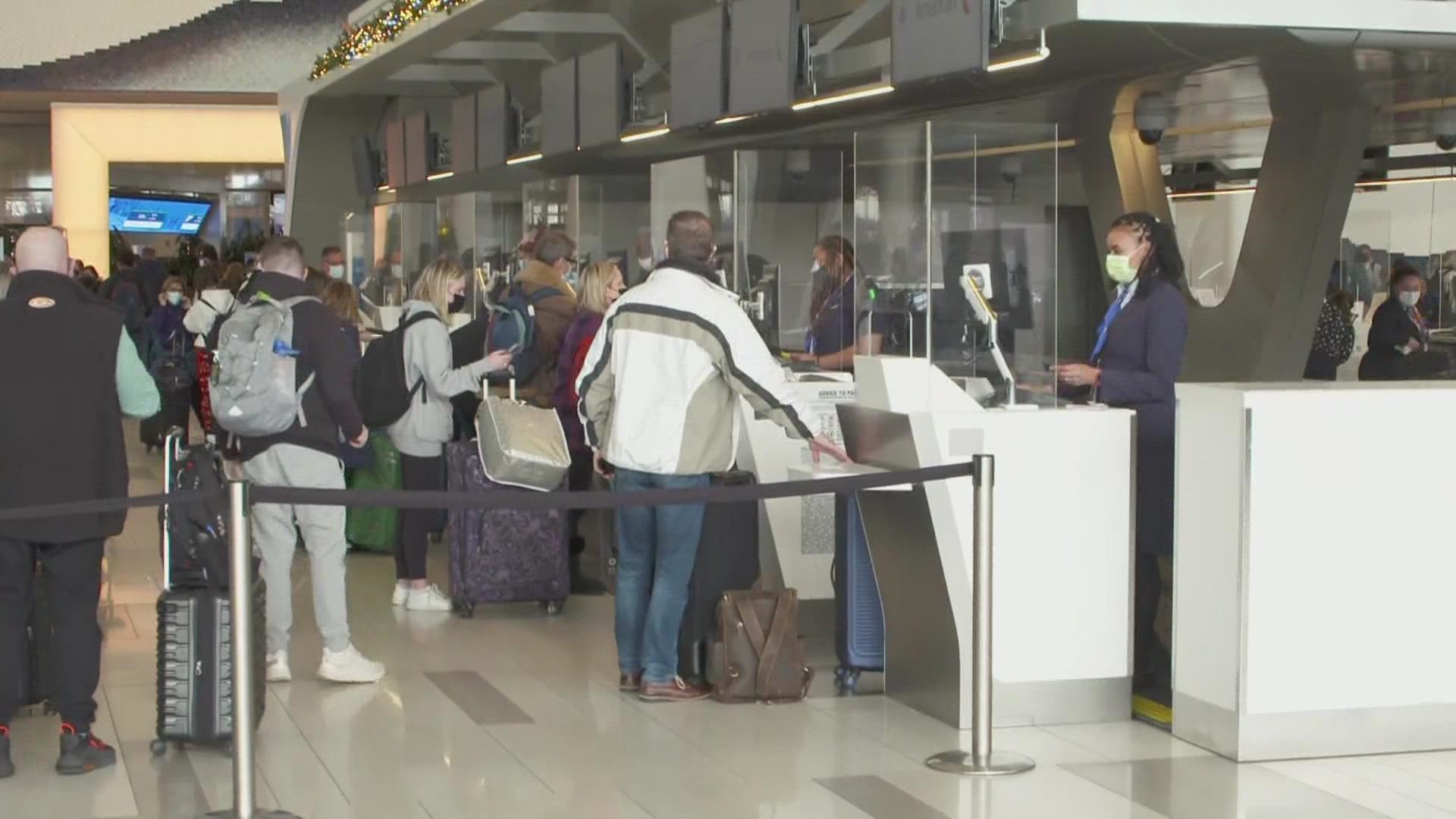SAN ANTONIO — San Antonio's official COVID-19 risk indicator was upgraded to the middle threshold of medium Tuesday for the first time since an ongoing uptick in new cases began at the end of April.
June has averaged 544 new daily coronavirus infections, which is almost double the 274 cases yielded each day in May. Another 645 cases were announced by Metro Health Tuesday – the third-largest one-day total since the tail-end of the omicron surge in February – and local COVID-19 hospitalizations, while down from Monday, have risen 56% since May 1.
Of the 139 patients receiving treatment at local facilities Tuesday, 27 were in intensive care and 12 were using ventilators to help them breathe. And for a second straight day, another resident has died of virus complications.
More than 558,000 Bexar County residents have been diagnosed with COVID-19, while 5,333 have died from virus complications.
How Bexar County is trending




Vaccine Progress in Bexar County
The following numbers are provided by San Antonio Metro Health. A full breakdown can be found here.
- 1.455 million eligible Bexar County residents are fully vaccinated as of Monday, June 6.
- More than 548,000 eligible Bexar County residents have received their COVID-19 booster shot, as of Monday, June 6.
The CDC states that "when a high percentage of the community is immune to a disease (through vaccination and/or prior illness)," that community will have reached herd immunity, "making the spread of this disease from person to person unlikely."
The City of San Antonio breaks down the vaccination rates by zip code on Metro Health's Vaccination Statistics page.
Coronavirus in Texas
The total number of coronavirus cases in the state since the pandemic began grew by 6,862 on Tuesday, according to the Texas Department of State Health Services. That total includes 4,824 new confirmed cases and 2,038 new probable cases. More details can be found on this page.
Tuesday's figures bring the total number of Texans diagnosed with COVID-19 to more than 6.95 million.
An additional eight Texans have died from virus complications, meanwhile, raising the statewide death toll to 86,922.
Coronavirus symptoms
The symptoms of coronavirus can be similar to the flu or a bad cold. Symptoms include fever or chills, cough, shortness of breath or difficulty breathing, fatigue, muscle or body aches, headache, new loss of taste or smell sore throat, congestion or runny nose, nausea or vomiting, and diarrhea, according to the Centers for Disease Control.
Most healthy people will have mild symptoms. A study of more than 72,000 patients by the Centers for Disease Control in China showed 80 percent of the cases there were mild.
But infections can cause pneumonia, severe acute respiratory syndrome, kidney failure, and even death, according to the World Health Organization. Older people with underlying health conditions are most at risk.
Experts determined there was consistent evidence these conditions increase a person's risk, regardless of age:
- Chronic kidney disease
- COPD (chronic obstructive pulmonary disease)
- Obesity (BMI of 30 or higher)
- Immunocompromised state (weakened immune system) from solid organ transplant
- Serious heart conditions, such as heart failure, coronary artery disease, or cardiomyopathies
- Sickle cell disease
- Type 2 diabetes
- The CDC believes symptoms may appear anywhere from two to 14 days after being exposed.
Human coronaviruses are usually spread...
- Between people who are in close contact with one another (within about 6 feet).
- Through respiratory droplets produced when an infected person coughs, sneezes or talks. These droplets can land in the mouths or noses of people who are nearby or possibly be inhaled into the lungs.
- Some recent studies have suggested that COVID-19 may be spread by people who are not showing symptoms.
Help stop the spread of coronavirus
- Stay home when you are sick.
- Eat and sleep separately from your family members
- Use different utensils and dishes
- Cover your cough or sneeze with your arm, not your hand.
- If you use a tissue, throw it in the trash.
Find a Testing Location
City officials recommend getting a COVID-19 test if you experience fever or chills, cough, shortness of breath or difficulty breathing, fatigue, muscle or body aches, headache, new loss of taste or smell, sore throat, congestion or runny nose, nausea or vomiting, or diarrhea.
Here's a Testing Sites Locator to help you find the testing location closest to you in San Antonio.
Latest Coronavirus Headlines
- What the WHO now has to say about the origin of COVID
- Service members opposed to COVID vaccines because of religion have new option with Novavax
- FDA advisers back Novavax COVID-19 shots as new US option
- FDA: Pfizer COVID-19 shot appears safe, effective for kids under 5
- People with food allergies may be less prone to COVID infection, study finds
- Many baby formula plants weren't inspected because of COVID
- US lifts COVID-19 test requirement for international travel
- White House outlines plan for 1st COVID shots for kids under 5
- No satisfaction: Jagger has COVID, Rolling Stones gig off

